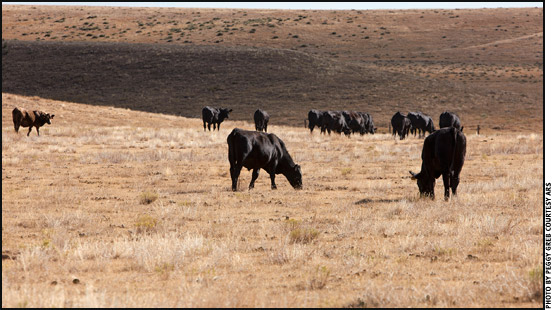
Ranchers in the central Great Plains can use a newly expanded computer model developed by ARS scientists to see which cattle or sheep stocking rate scenarios are the most sustainable for their semi-arid rangeland.
Calculating Livestock Numbers
by Weather and Climate
Ranchers in the central Great Plains may be using some of their winter downtime in the future to rehearse the upcoming production season, all from the warmth of their homes, according to U.S. Department of Agriculture (USDA) soil scientists.
The ranchers would use the GPFARM (Great Plains Framework for Agricultural Resource Management)-Range computer model to see which cattle or sheep stocking rate scenarios are sustainable. Soil scientists Gale Dunn and Laj Ahuja with USDA's Agricultural Research Service (ARS) are testing the model in enough locations to get the model fully usable throughout the central Great Plains.
Dunn and research leader Ahuja work at the ARS Agricultural Systems Research Unit in Fort Collins, Colo. ARS is USDA's principal intramural scientific research agency, and this research supports the USDA priority of promoting agricultural sustainability.
The model would allow ranchers to test various scenarios involving forage yields and the weight gains of beef cattle and calves and other livestock under various stocking and weather scenarios. The high variability of precipitation makes it difficult to choose a stocking rate that is the best balance between economic and rangeland sustainability.
Looking at National Weather Service seasonal weather predictions, ranchers would judge whether precipitation in the coming season would likely be normal or above or below normal.
GPFARM-Range is one of a few range models that can factor in the effects of climate change on stocking rates, predicting the response of forage plants to increased carbon dioxide and higher temperatures.
The model was originally developed and tested in Cheyenne, Wyo.
 The most recent tests of the model were on sheep pastures in Miles City, Mont., and beef cattle pastures at Fort Supply, near Woodward, Okla. The Oklahoma test taught the scientists to account for forage yield losses from soil compaction at higher stocking rates. The results of these tests have been published in Rangeland Ecology and Management.
The most recent tests of the model were on sheep pastures in Miles City, Mont., and beef cattle pastures at Fort Supply, near Woodward, Okla. The Oklahoma test taught the scientists to account for forage yield losses from soil compaction at higher stocking rates. The results of these tests have been published in Rangeland Ecology and Management.
Read more about this research in the March 2011 issue of Agricultural Research magazine.
A CD of GPFARM-Range is available by email.
[Click here to go to the top of the page.]









